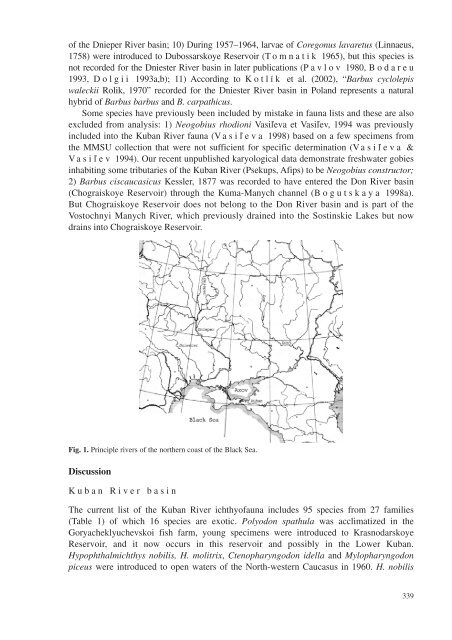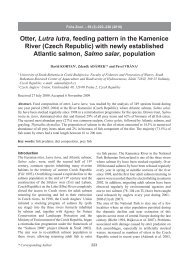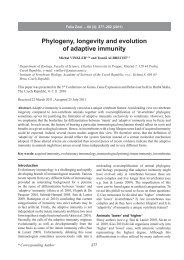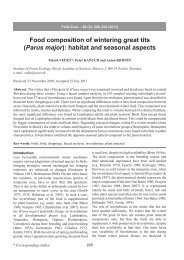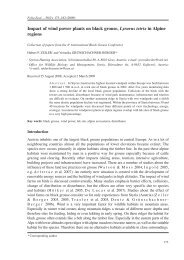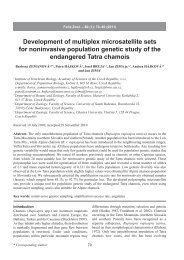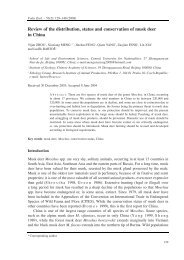alterations in ichthyofauna of the largest rivers
alterations in ichthyofauna of the largest rivers
alterations in ichthyofauna of the largest rivers
You also want an ePaper? Increase the reach of your titles
YUMPU automatically turns print PDFs into web optimized ePapers that Google loves.
<strong>of</strong> <strong>the</strong> Dnieper River bas<strong>in</strong>; 10) Dur<strong>in</strong>g 1957–1964, larvae <strong>of</strong> Coregonus lavaretus (L<strong>in</strong>naeus,<br />
1758) were <strong>in</strong>troduced to Dubossarskoye Reservoir (T omnatik 1965), but this species is<br />
not recorded for <strong>the</strong> Dniester River bas<strong>in</strong> <strong>in</strong> later publications (Pavlov 1980, B odareu<br />
1993, Dolgii 1993a,b); 11) Accord<strong>in</strong>g to Kotlík et al. (2002), “Barbus cyclolepis<br />
waleckii Rolik, 1970” recorded for <strong>the</strong> Dniester River bas<strong>in</strong> <strong>in</strong> Poland represents a natural<br />
hybrid <strong>of</strong> Barbus barbus and B. carpathicus.<br />
Some species have previously been <strong>in</strong>cluded by mistake <strong>in</strong> fauna lists and <strong>the</strong>se are also<br />
excluded from analysis: 1) Neogobius rhodioni Vasiºeva et Vasiºev, 1994 was previously<br />
<strong>in</strong>cluded <strong>in</strong>to <strong>the</strong> Kuban River fauna (V asiºeva 1998) based on a few specimens from<br />
<strong>the</strong> MMSU collection that were not sufficient for specific determ<strong>in</strong>ation (V asiºeva &<br />
Vasiºev 1994). Our recent unpublished karyological data demonstrate freshwater gobies<br />
<strong>in</strong>habit<strong>in</strong>g some tributaries <strong>of</strong> <strong>the</strong> Kuban River (Psekups, Afips) to be Neogobius constructor;<br />
2) Barbus ciscaucasicus Kessler, 1877 was recorded to have entered <strong>the</strong> Don River bas<strong>in</strong><br />
(Chograiskoye Reservoir) through <strong>the</strong> Kuma-Manych channel (B ogutskaya 1998a).<br />
But Chograiskoye Reservoir does not belong to <strong>the</strong> Don River bas<strong>in</strong> and is part <strong>of</strong> <strong>the</strong><br />
Vostochnyi Manych River, which previously dra<strong>in</strong>ed <strong>in</strong>to <strong>the</strong> Sost<strong>in</strong>skie Lakes but now<br />
dra<strong>in</strong>s <strong>in</strong>to Chograiskoye Reservoir.<br />
Fig. 1. Pr<strong>in</strong>ciple <strong>rivers</strong> <strong>of</strong> <strong>the</strong> nor<strong>the</strong>rn coast <strong>of</strong> <strong>the</strong> Black Sea.<br />
Discussion<br />
Kuban River bas<strong>in</strong><br />
The current list <strong>of</strong> <strong>the</strong> Kuban River <strong>ichthy<strong>of</strong>auna</strong> <strong>in</strong>cludes 95 species from 27 families<br />
(Table 1) <strong>of</strong> which 16 species are exotic. Polyodon spathula was acclimatized <strong>in</strong> <strong>the</strong><br />
Goryacheklyuchevskoi fish farm, young specimens were <strong>in</strong>troduced to Krasnodarskoye<br />
Reservoir, and it now occurs <strong>in</strong> this reservoir and possibly <strong>in</strong> <strong>the</strong> Lower Kuban.<br />
Hypophthalmichthys nobilis, H. molitrix, Ctenopharyngodon idella and Mylopharyngodon<br />
piceus were <strong>in</strong>troduced to open waters <strong>of</strong> <strong>the</strong> North-western Caucasus <strong>in</strong> 1960. H. nobilis<br />
339


